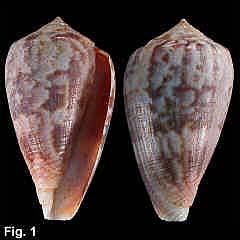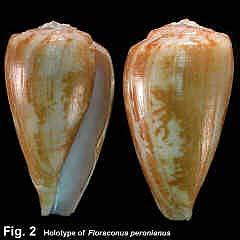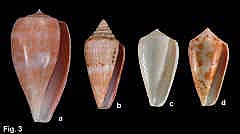|
|
|
|
|
Conus anemone Lamarck, 1810 Description: This is a variable species. NSW shells light to medium in weight, relatively tall with body whorl uniformly convex, or convex posteriorly and slightly concave towards the base. Entire body whorl sculptured with spiral ridges, often weaker midbody. Spire flat to medium in height, spire whorls with 5-8 spiral threads. Aperture wider anteriorly, outer lip convex. Background colour bluish-grey, with irregular brown patches , which may coalesce into axial or spiral bands. Aperture bluish-white in deep interior, brownish-purple at outer edge. Size: Up to 76 mm in length, typically 25-35 mm in NSW. Distribution: Endemic to Australia; Southern Queensland to Houtman Abrolhos, WA, including Tasmania and Lord Howe Is. Habitat: Low intertidal and subtidal on the open coast, down to 55 m; under rocks and ledges on rocky shores and on sand among algae or eel-grass. Common in SA and Victoria, uncommon in NSW. Remarks: This species varies in shape, weight of shell, spire height and colour throughout its range. Some forms are restricted to geographical areas, while others appear adapted to a particular ecological situation. Many of the forms have been described as full species, but as there is continuous variation between them, they are best regarded as forms. The typical intertidal form from NSW is relatively small, with a low to moderate spire and blue-grey background colour (Fig. 1). Conus peronianus (Iredale, 1931) was assigned to large, inflated, relatively light weight and smooth shells with low spire and often a bright colour (Figs. 2, Holotype. Fig. 3a). It was based on a specimen from Sydney Harbour, but the form occurs throughout the range of the species. Conus carmeli (Tenison-Woods, 1877) has a tall to very tall spire (Fig. 3b). (This form has been erroneously identified as C. compressus (Sowerby, 1866), which is actually a localised variant from the Houtman Abrolhos, WA). Among the other forms are Conus singletoni (Cotton, 1945), which is an albino form (Fig. 3c) and Conus remo Brazier, 1898 based on bright orange markings (Fig. 3d). Another shell, similar to the NSW form of C. anemone, occurs in north-western WA, isolated from the southern distribution by a distance of about 1000 km. Some authors regard this shell as a full species, C. novaehollandiae Adams, 1854 , while others regard it as a subspecies or form of C. anemone. Fig. 1 Terrigal, NSW (C.135784) Fig. 2 Holotype of Floraconus peronianus Iredale, 1931. Sydney Harbour (C.057869) Fig. 3 a. peronianus form. Langton Is, SA (DLB4658) b. carmeli form. Ceduna, SA (DLB1024) c. singletoni form. Victoria (C.135798) d. remo form. Thistle Is., Spencers Gulf, SA (C.135804) |


